Back
to Lecture 18
BACK
TO DINOSAURS 2001 HOME PAGE
Lecture 19
Solnhofen - Birds ARE Dinosaurs!
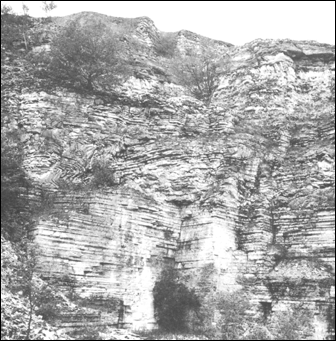
|
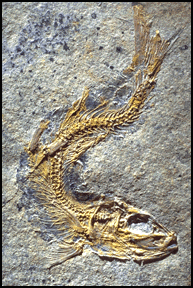
|
| Outcrop at Solnhofen of the Plattenkalk. Note the very thin bedding
laid down in a quite lagoon surrounded by reefs, This platy, very fine-grained
limestone was, and still used used for roofing tiles and especially for
the making of lithographic plates. |
Nearly perfectly preserved small teleost fish from Solnhofen, Bavaria.
Fish is only two inches long. This preservation is typical of what occurs
in bodies of water, such as the lagoons of Solnhofen, that lack oxyen at
the bottom. The lack of oxygen and the lack of currents excluded scavangers
and disruptive physical conditions resulting in superb preservation. Unfortunately,
it is very rare for a terrestrial organism to find its way into this sort
of an environment. |
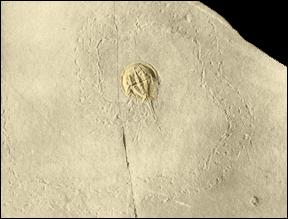
Horseshoe crab (Mesolimulus) death trail.
Saurischia
Coelurosauria
Compsognathus longipes is a small theropod, coelurosaurian
dinosaur from Solnhofen. The type specimen (below) has in its gut region
the remains of a small long-tailed lizard. There are no signs of scale
or feather impressions. If a specimen such as this were to have impressions
of its integument, there would be some basis for knowing if small dinosaurs
has an insulatory coating of feathers.
On the right is a lithograph of Compsognathus longipes
from Solnhofen. This lithograph was made on the lithographic limestone
from Solnhofen itself. Such lithographic plates are the reason the quarries
were opened in the first place. If you click on the image, you will go
to a web site in which Compsognathus is described in more detail. |
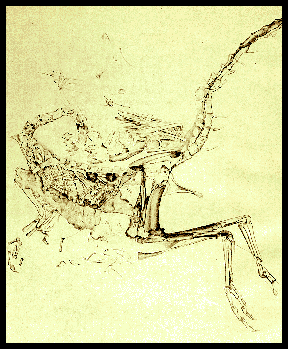 |
Maniraptora
1. three-toed foot
2. digits IV and V lost on hand
3. long arms
4. semilunate carpal
5. fused pelvis
6. large hole in lacrimal bone in skull
7. ?no unique derived characters?
8. giant, hook-like claw on digit II of pes
9. flight feathers
10. ?no unique derived characters? |
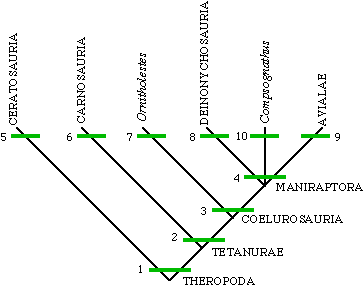
Cladogram of the Theropoda |
Aves
Archaeopteryx lithographica
Below is the Berlin specimen of Archaeopteryx from the Solnhofen
Limestone. It was the third specimen found, and unquestionably the most
spectacular specimen found to date. Particularly noteworthy are the very
fine feather impressions, including the flight feathers of the wings. Despite
its' obvious avian nature, Archaeopteryx has a hand virtually identical
to other maniraptoran dinosaurs such as Velociraptor.
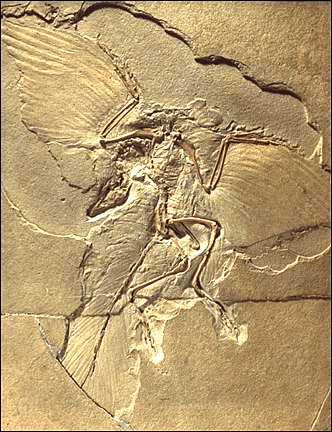
Bird and Dinosaur Features
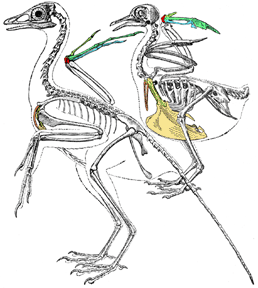 |
Comparison of reconstructed skeleton of Archaeopteryx (left)
and a pigeon (right). Key to homologous bones follows: yellow, sternum
(breastbone); orange, furcula = fused clavicles (wishbone); yellow, coracoids;
red, semilunate carpal; yellow-green, digit I of manus; green, digit II
of manus; blue, digit III of manus. This drawing is modified from Gerhard
Heilmanns classic monograph "The Origin of Birds".
Note the long tail, separate fingures of the manus, and small
sternum of Archaeopteryx, all primitive features inhereted virtually
without modification of non-bird maniraptorans. |
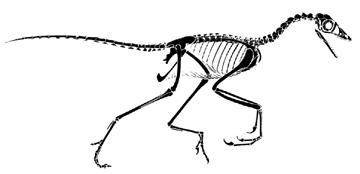 |
Reconstruction of Archaeopteryx (based on Paul, 1988). Note
the amazing similarity to the sketon of another. larger maniraptoran, Deinonychus
from the Early Cretaceous Cloverly Formation of Montana. |
 |
Reconstruction of the skeleton of Deinonychus (modified from
Paul, 1987) |
Some of the strongest and most convincing evidence of the maniraptoran
origin of birds is in the comparision between the manus of various non-bird
dinosaurs and a modern bird, the Hoatzin, from South America.
It is unique in a number of ways among birds. First, the young
(see below) have claws of well developed fingers. They jump from their
nests to escap predators (mostly snakes) and then return to the nest by
clibing back up using their manus. In addition the Hoatzin is the only
bird that has developed a foregut in which cellulose digestion takes place,
aided by bacterial fermentation. It is a true folivore - it eats leaves
(see www.knowledge.co.uk/frontiers/sf066/sf066b06.htm).
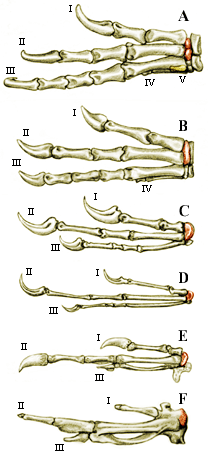
|
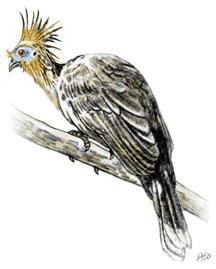
On the left is a comparison of the left manus of a variety
of theropod dinosaurs all drawn so that digit II is of the same length.
The semilunate carpal and its homologues are shaded red.
A. Herrerasaurus (based on Sereno, 1993). Note that
all five digits are present, which of course is primitive for the Amniota.
Digit V is shaded yellow and would be hidden on the other side of the manus
from this view.
B. Coelophysis (based on Colbert, 1989). Note that
digit V is gone.
C. Deinonychus (based on Ostrom, 1969). Note loss
of both digits IV and IV - the tetanurine condition.
D. Archaeopteryx (based on Heilmann, 1927). Note
very close correspondence in proportions and relative lengths of bones
to Deinonychus.
E. Hoatzin embryo Opisthocomus (based on Heilmann,
1927). Note reduction of number of bones in digit III.
F. Hoatzin adult Opisthocomus (based on Heilmann,
1927). Most of the bones of the manus fuse up in the adult, including the
emilunate carpal to the metacarpals. |
References:
Colbert, E. H., 1989, The Triassic dinosaur Coelophysis.
Museum of Norther Arizona Bull. 57, p. 1-160.
Heilman, G., 1927, The Origin of Birds. D. Appleton and Company,
21 pp.
Ostrom, J. H.., 1969, Osteology of Deinonychus antirrhopus,
and unusual theropod from the Lower Cretaceous of Montana. Peabody Musuem
of Natural Histroy, Bull. 30, p. 1-165.
Paul, G. S., 1987, The science and art of restoring the life appearance
of dinosaurs and their relatives:a rigorous how-to-guide. in Czerkas, S.
J. and Olseon, E. C. (eds.) Dinosaurs Past and Present, Volume II, p. 6-49.
Paul, G. S., 1988, Predatory Dinosaurs of the World. Simon and
Schuster, New York, 464 pp.
Sereno, P. C., 1993, The pectoral girdle and forelimb of the basal
theropod Herrerasaurus ischigulastensis. Jour. Vert. Paleo., v.
13, no. 4, p. 425-450.
Go to Lecture 20
BACK TO SYLLABUS
BACK TO THE DINOSAUR AND THE HISTORY OF LIFE
HOME PAGE










